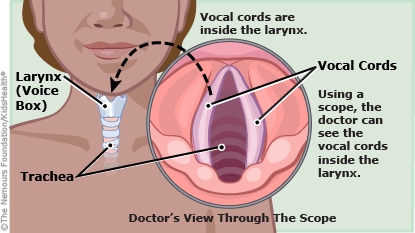Laryngoscopy (lair-en-GOS-kuh-pee) is a procedure health care providers do to look inside the larynx (voice box), which is below the back of the throat. In direct laryngoscopy, they use an instrument called a laryngoscope (leh-RIN-geh-skope) (or scope, for short) to look directly at the larynx (LAIR-inks).
Your child was watched after the procedure and now can be cared for at home. Usually, there are no problems after direct flexible laryngoscopy. Your child's nose and throat might feel numb or swollen for a little while after the procedure. They might have some soreness in their nose or throat or some hoarseness for a day or two.

What are the types of laryngoscopes? Two main types of scopes are used for direct laryngoscopy:
- Rigid laryngoscopy: The health care provider uses a firm scope that doesn't bend. It is inserted through the child's mouth into the throat. It lights the inside of the throat and enlarges the view. Usually, it's done while the child is under general anesthesia. The procedure can help a health care provider remove foreign objects or growths, collect tissue samples to examine in a lab, or do laser treatment.
- Flexible laryngoscopy: The health care provider uses a thin flexible tube that can be inserted through the nose or mouth. It has a light and camera on the end, letting the health care provider see the throat through the scope's eyepiece or on a monitor in the room. Usually, it's done in the office or clinic with the child awake, using numbing medicine for the throat. Sometimes it's done while the child is under general anesthesia. The procedure can help a health care provider diagnose problems in the throat and larynx.




